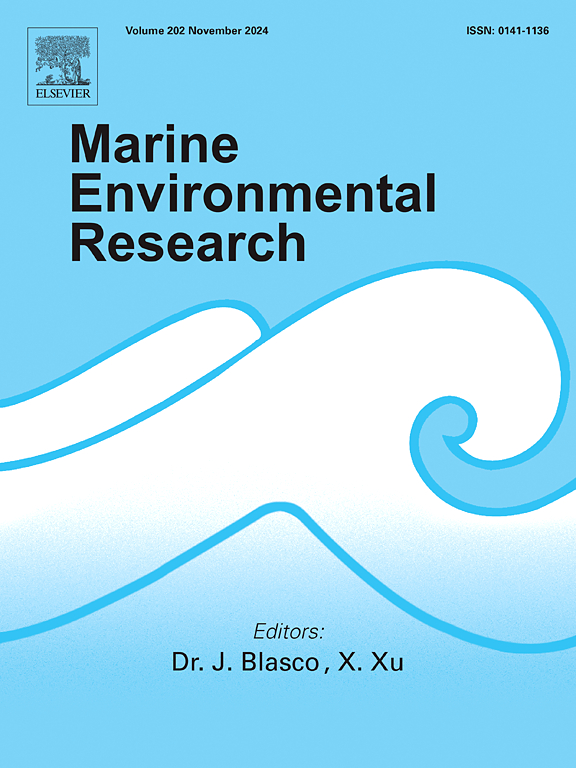猎物吞噬是异养鞭毛藻甲基汞摄取的主要途径
IF 3.2
3区 环境科学与生态学
Q2 ENVIRONMENTAL SCIENCES
引用次数: 0
摘要
研究了甲鞭毛藻对甲基汞(MeHg)的吸收,以确定在8小时暴露期间,来自溶解相的吸收或猎物吞噬的吸收对细胞甲基汞积累的贡献更大。考察了溶解有机碳(DOC)浓度、盐度和温度等不同环境因素的影响。总的假设是,利用异养的鞭毛藻会由于猎物的吞噬而积累更多的甲基汞,而不是通过摄取甲基汞- doc复合物。此外,我们还假设,在对O. marina最适宜且依赖于温度的盐度下,甲基汞的吸收量最高。通过不同的实验室实验来验证这些假设:1.)溶解有机物浓度和猎物存在(DOC: 130 μM vs. 210 μM vs. Isochrysis galbana作为猎物,5 × 105细胞mL−1);2.)盐度(11、17和34);(3)温度(12、15和22°C),代表温带河口的可能条件。结果表明,有浮游植物捕食时,MeHg的吸收量最高,不同DOC浓度间的吸收量无显著差异。在含盐处理中,与17和34处理相比,11处理的水体MeHg吸收量显著降低。与假设相反,温度对甲基汞的吸收没有影响。总的来说,这些研究支持了甲藻捕食浮游植物增加其MeHg负担的假设,并提供了在DOC存在下影响异养原生生物同化MeHg的对比因素的更多细节。本文章由计算机程序翻译,如有差异,请以英文原文为准。

Prey engulfment as the dominant pathway of methylmercury uptake in a heterotrophic dinoflagellate
Methylmercury (MeHg) uptake by the dinoflagellate Oxyrrhis marina was investigated to determine if uptake from the dissolved phase or prey engulfment contribute more to cellular MeHg accumulation during 8-h exposures. Effects of varying environmental factors were examined, including dissolved organic carbon (DOC) concentration, salinity, and temperature. The overarching hypothesis was that dinoflagellates utilizing heterotrophy would accumulate higher MeHg due to prey engulfment than from the uptake of MeHg-DOC complexes. Furthermore, it was hypothesized that MeHg uptake would be highest at the salinity optimal for O. marina and dependent on temperature. Laboratory experiments were carried out to test these hypotheses by varying: 1.) dissolved organic matter concentration and prey presence (DOC: 130 vs. 210 μM vs. Isochrysis galbana as prey at 5 × 105 cells mL−1); 2.) salinity (11, 17, and 34); and 3.) temperature (12, 15, and 22 °C), representing possible conditions in a temperate estuary. Results show that MeHg uptake was highest in the presence of phytoplankton prey, and there was no significant difference in uptake between DOC concentrations. Among salinity treatments, MeHg uptake from water was significantly lower at 11, compared to 17 and 34. Contrary to what was hypothesized, temperature had no effect on MeHg uptake. Overall, these studies support the hypothesis that the consumption of phytoplankton prey by this dinoflagellate increases its MeHg burden, and provide more detail of the contrasting factors influencing MeHg assimilation by heterotrophic protists in the presence of DOC.
求助全文
通过发布文献求助,成功后即可免费获取论文全文。
去求助
来源期刊

Marine environmental research
环境科学-毒理学
CiteScore
5.90
自引率
3.00%
发文量
217
审稿时长
46 days
期刊介绍:
Marine Environmental Research publishes original research papers on chemical, physical, and biological interactions in the oceans and coastal waters. The journal serves as a forum for new information on biology, chemistry, and toxicology and syntheses that advance understanding of marine environmental processes.
Submission of multidisciplinary studies is encouraged. Studies that utilize experimental approaches to clarify the roles of anthropogenic and natural causes of changes in marine ecosystems are especially welcome, as are those studies that represent new developments of a theoretical or conceptual aspect of marine science. All papers published in this journal are reviewed by qualified peers prior to acceptance and publication. Examples of topics considered to be appropriate for the journal include, but are not limited to, the following:
– The extent, persistence, and consequences of change and the recovery from such change in natural marine systems
– The biochemical, physiological, and ecological consequences of contaminants to marine organisms and ecosystems
– The biogeochemistry of naturally occurring and anthropogenic substances
– Models that describe and predict the above processes
– Monitoring studies, to the extent that their results provide new information on functional processes
– Methodological papers describing improved quantitative techniques for the marine sciences.
 求助内容:
求助内容: 应助结果提醒方式:
应助结果提醒方式:


